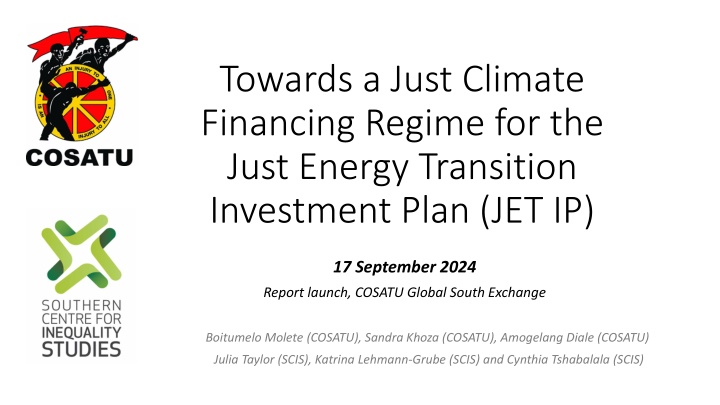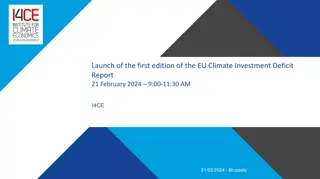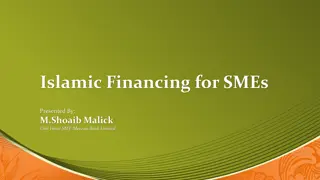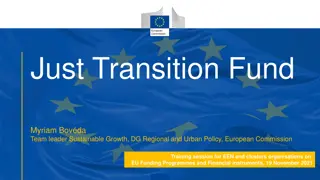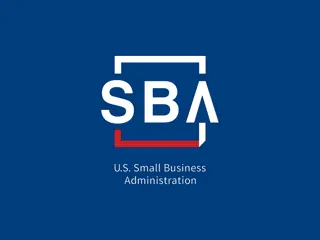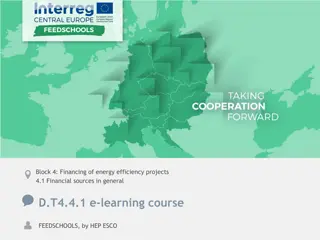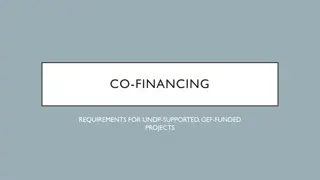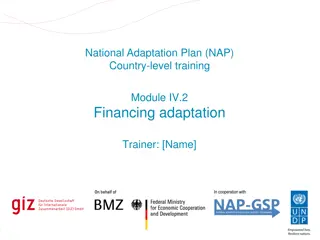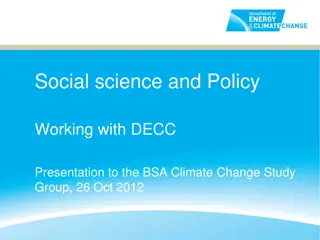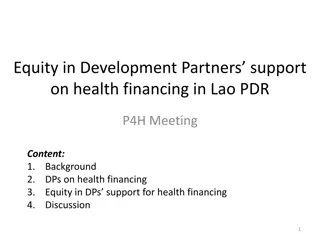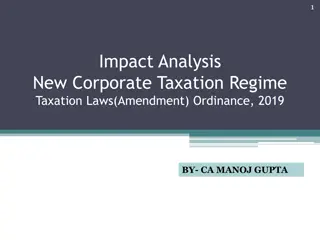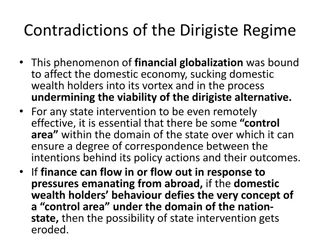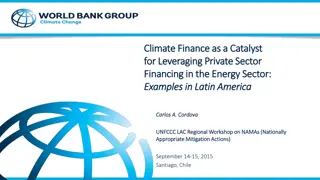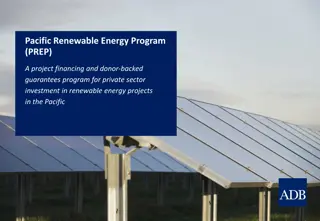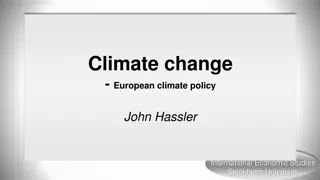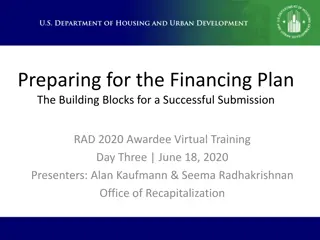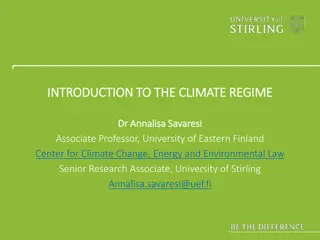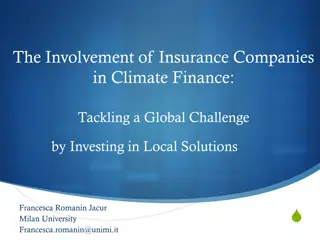Just Energy Transition Investment Plan for Climate Financing Regime
Report launch highlights the need for a just transition in energy investment plans, discussing climate finance in South Africa, emphasizing social ownership, alternative financing options, and more.
Download Presentation

Please find below an Image/Link to download the presentation.
The content on the website is provided AS IS for your information and personal use only. It may not be sold, licensed, or shared on other websites without obtaining consent from the author.If you encounter any issues during the download, it is possible that the publisher has removed the file from their server.
You are allowed to download the files provided on this website for personal or commercial use, subject to the condition that they are used lawfully. All files are the property of their respective owners.
The content on the website is provided AS IS for your information and personal use only. It may not be sold, licensed, or shared on other websites without obtaining consent from the author.
E N D
Presentation Transcript
Towards a Just Climate Financing Regime for the Just Energy Transition Investment Plan (JET IP) 17 September 2024 Report launch, COSATU Global South Exchange Boitumelo Molete (COSATU), Sandra Khoza (COSATU), Amogelang Diale (COSATU) Julia Taylor (SCIS), Katrina Lehmann-Grube (SCIS) and Cynthia Tshabalala (SCIS)
Process of developing this Process of developing this report report Commissioned by COSATU in response to the JET IP and some of its critical flaws This report aims to: Briefly review the plan and understand its implications for workers Propose an alternative set of principles and approaches to financing the just transition Advocate for social ownership within the just transition Based on desktop research, 4 focus groups with affiliates, and interviews with external experts and the COSATU climate change committee, and consultative workshop
Contents Contents 1. Introduction 2. Climate finance in South Africa to date 3. Just Energy Transition Investment Plan (JET IP) 4. Priorities for a just transition 5. Social ownership 6. Alternative financing options 7. Conclusion
1. Introduction 1. Introduction The just transition concept is gaining speed in SA - however, there is a sense amongst workers that an unjust transition is underway and it has been hijacked by private interests. Just energy transition (JET) remains NB to address climate change and the energy crisis (loadshedding and increasing costs). The JET is expensive - how should it be financed? The JET partnership (with EU, Germany, France, UK and USA) and JET IP are inadequate and problematic and will not produce a just transition. Other countries pursuing JET partnerships can learn from some of the issues they have caused in SA We need a new vision and systematic change in approach to the just energy transition social ownership must play a central role.
2. Climate finance in South Africa to date 2. Climate finance in South Africa to date In 2017 and 2018: oTotal of R62.2 billion o25% public finance oMost of it in the form of debt (not equity) oHeavily focused on the private sector and private interests almost no private financing for adaptation which can be linked to broader social development Development finance institutions: ohave contributed very little ofocus on providing opportunities for the private sector oActively push for privatisation and corporatisation of energy SOEs.
Box: Box: South Africa in debt National debt R4.73 trillion Debt servicing R366.8 billion annually Debt is used to justify austerity practices including budget cuts to public services Eskom also has significant debt - R423 billion Debt restructuring under strict conditions including restricting Eskom s expenditure to transmission and distribution and further increases to tariffs
3. Just Energy Transition Investment Plan 3. Just Energy Transition Investment Plan In 2021, the EU, France, Germany, the UK, and the USA (the IPG) signed a deal with SA, providing approx. R128 billion ($8.5b) in climate finance for the just transition. In the year that followed, the JET IP was developed by the Presidential Climate Finance Task team, approved by Cabinet and then published for public comment. It outlines the priorities for a just energy transition and the scale of need and the investments required to support decarbonisation commitments in South Africa a total of R1.5 trillion by 2027. Priority areas: electricity, new energy vehicles and green hydrogen. Many have supported the need for the plan, and have found it useful that it quantifies the expected costs of the transition.
3. JET IP 3. JET IP Critiques Critiques A focus on profitable sectors for private investment, rather than what is urgently needed for a just energy transition. It barely tackles the issue of social protection to workers and communities. 'Cost-reflective tariffs' are emphasised, yet the issue of electricity affordability is not adequately addressed. The plan does not include fiscal, monetary, and industrial policy, leaving the state's position unclear. The process of developing the plan and the terms of the funding have not been transparent. The form of the partnership with SA and several international partners does not give South Africa much leverage in negotiations.
3. JET IP 3. JET IP - - Recommendations Recommendations The JET IP is focused on, and mainly, benefits the private sector - not workers or communities. COSATU and its affiliates are calling for a public-led pathway to a just transition which prioritises public benefit for all. Direct government investments are necessary to address energy access and affordability while supporting decarbonisation. Fiscal, monetary, and industrial policies must also be completely integrated. COSATU: Has contested the privatisation of the energy system Has proposed alternatives to private ownership of the energy system Is proposing alternative priorities of the JET IP which address energy poverty, livelihoods and well-being as opposed to private sector profit.
4. Priorities for a just energy transition 4. Priorities for a just energy transition Employment and social protection Stakeholder participation Education, skills and training development Affordable and accessible electricity A public-led pathway
5. Social ownership 5. Social ownership Privatisation is not the only way to rollout renewables other models are possible. Has always been part of unions demands for the just transition and has become common cause against the wave of privatisation we are seeing. Particularly important in SA - massive inequality and highly concentrated wealth and ownership. The Just Transition Framework calls for a diversely owned renewable system and a broadening of ownership of productive assets in support of a just transition. R1.65 billion is allocated for piloting social ownership models in the JET-IP. Concern that privatisation will contribute to escalating electricity prices and energy poverty.
The socialist definition: Where the benefits, profits and wealth produced by the means of production, are shared amongst society as a whole. What is social ownership? What is social ownership? Type Public ownership Explanation The government has a majority ownership of the entity Example Eskom in SA/ Vattenfall in Sweden which has 35% renewable energy Municipal ownership The municipality has a majority ownership of the entity Steenbras Hydroelectric Power Station owned by City of Cape Town Ilinge Labahlali Housing Co-operative in Cape Town Cooperatives An entity which is owned and run by individuals or a community This is where a company is majority locally owned but not focused on local benefit For-profit cooperative Cogecom in Brazil is an electricity cooperative which provides 405MW and serves 12 000 customers Public-Private Partnerships (PPPs) Employee Share Ownership Programmes (ESOPs) Open investment model State entities share ownership with private entities Various infrastructure projects e.g. SANRAL Company employees own shares in the company Ikageng Employee share trust Coca Cola Beverages An entity allows for ownership by individuals The Sun Exchange crowdfunded solar company in SA Split-ownership model Ownership of an entity includes companies and REI4P Community Trusts *Draft not to be distributed or cited individuals
What is true social ownership? What is true social ownership? Based on the inputs during fieldwork, COSATU affiliates do not feel that all the models listed in the table can really be called social ownership. Suggested criteria for true social ownership: 1. Popular ownership 2. Social mandate and social benefit 3. Meaningful participation 4. Equality and redistribution 5. Transparency 6. Social accountability A key message in the focus groups was that entities with a profit motive are therefore not social ownership because they do not meet the above criteria.
Public ownership Public ownership Public ownership is the most appropriate and truest form of social ownership as it is: o Mandated to provide services for all o Accountable to citizens o An NB mechanism for redistribution But many are failing e.g. Eskom, and the state has committed to austerity and reducing spending on public services. Nonetheless, a JET requires competent planning and leadership which can only be provided by the state . Therefore, it is necessary to invest in and support our public entities COSATU and other allies have put through proposals on this already. Eskom must be transformed to ensure accountability and transparency in its activities and to restructure its operations for optimal public benefit. Municipal ownership is also an option and form of public ownership.
Cooperatives Cooperatives Coops can also be a form of social ownership. But the experience in SA has been mixed although there has been a push for them, many have failed. One suggestion was that coops should form around already existing groups e.g. faith groups or stokvels. Overall, while there is a sense that coops could be useful, in practice their implementation has been mixed and that the need for capital can be exclusionary.
Other models Other models Because the goal of profit maximisation contradicts social ownership, certain models are excluded ESOPs and for-profit cooperatives. These are examples of shared ownership models. Many workers have negative experiences with ESOPs they are encouraged to leave their unions, do not always benefit from dividends and play almost no role in decision-making But these models can still hold some benefits to workers
6. Alternative financing options 6. Alternative financing options need for domestic finance domestic finance Financing a just transition cannot be done in isolation - it must be part of a broader discussion on SA s macro-economic framework e.g. how revenues are collected (and from whom) and austerity. need for The global north is responsible for paying its ecological debt but it doesn t providing small amounts, mostly in loans and it seems with pro-private conditionalities. Therefore, there is a preference for domestic financing increased state revenue, mitigating illicit financial flows
6. Alternative financing options 6. Alternative financing options options for domestic finance domestic finance Tax, part of a global discussion on tax justice wealth tax, extra taxes on polluting and extractive industries, taxes on luxury consumption, addressing IFFs E.g. a wealth tax on 354 000 individuals (top 1%) could raise at least R143 billion (Chatterjee, 2021) Worker pension funds and investment companies controversial It is clear that most workers do not know where their funds are currently invested education and consultation are key. Industrial Development Corporation should play a leading role to help drive the necessary industrial policy. options for
6. Alternative financing options 6. Alternative financing options international finance finance Finance from the global North, where used, should be mostly grants, must be transparent and inclusive and be done through multilateral process e.g. the Green Climate Fund. International finance should also include other partners e.g. BRICS New Development Bank and China. However, currently it is not a question of a lack of finance or kind of finance. The JET IP outlines a pathways that is inadequate to achieve a just transition and will likely exacerbate inequalities. Therefore, it is NB that we first have a just plan and a vision and then find the finance to suit it (rather than the other way round). international
7. Conclusion 7. Conclusion Reaffirms COSATU s support for a public-led pathway and public ownership as a form of social ownership Cooperatives (and shared ownership models) can be useful but have limitations Experience with all these models shows there are issues with implementation therefore the implementation of the principles is key Role of COSATU in advising the development of an alternative to the JET IP/its implementation plan
New developments Next phase in the process o JET IP was never revised, they rather released the implementation plan which was supposed to take into account some of the concerns o New focus areas are Municipalities, Skills.. Plans to include SA Renewable Energy Masterplan, Energy Efficiency and Road-to-Rail. New donors and new money still a lack of transparency o Netherlands, Switzerland, Spain, Canada, Denmark have also joined o Increased from $8.5 billion, to approx. $11.6 billion o No transparency on loans and conditions Grant projects underway Grant register was published but most of the grant money has been spent and hasn t benefitted workers or communities Donor countries decide on which projects to fund New projects on social ownership Lots of momentum about social ownership but do these projects meet the criteria? JET Implementation Plan
Many different policy documents on JET 1. Just Transition Framework Developed by the Presidential Climate Commission 2. Just Energy Transition Investment Plan Developed by the Presidential Climate Finance Task Team 3. Just Energy Transition Implementation Plan - Developed by the Climate Finance Task Team
